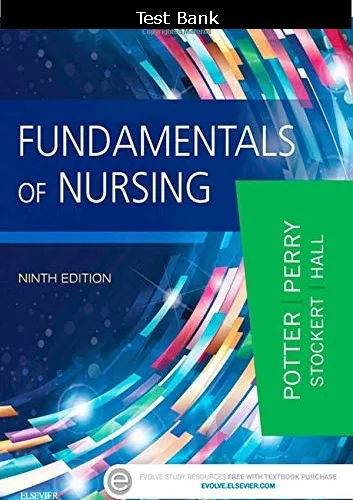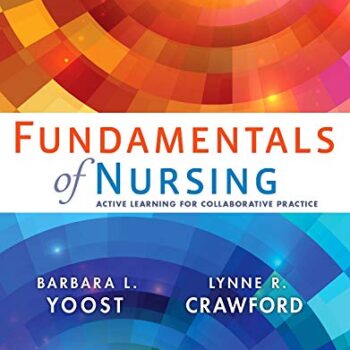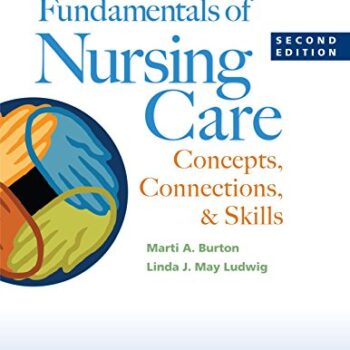Fundamentals of Nursing 9th Edition Potter Test Bank
$55.00 Original price was: $55.00.$13.50Current price is: $13.50.
Digital item No Waiting Time Instant Download
Chapters: 50
Format: PDF
ISBN-13: 978-0323327404
ISBN-10: 0323327400
Publisher: Mosby
Authors: Patricia A. Potter,
Anne Griffin Perry, Patricia A. Stockert, Amy Hall
Description
Fundamentals of Nursing 9th Edition Potter Test Bank
Table of Contents
1. Nursing Today
2. The Health Care Delivery System
3. Community-Based Nursing Practice
4. Theoretical Foundations of Nursing Practice
5. Evidence-Based Practice
Unit 2: Caring Throughout the Life Span
6. Health and Wellness
7. Caring in Nursing Practice
8. Caring for the Cancer Survivor
9. Culture and Ethnicity
10. Caring for Families
11. Developmental Theories
12. Conception Through Adolescence
13. Young to Middle Adult
14. Older Adult
Unit 3: Critical Thinking in Nursing Practice
15. Critical Thinking in Nursing Practice
16. Nursing Assessment
17. Nursing Diagnosis
18. Planning Nursing Care
19. Implementing Nursing Care
20. Evaluation
21. Managing Patient Care
22. Ethics and Values
23. Legal Implications in Nursing Practice
24. Communication
25. Patient Education
26. Documentation and Informatics
Unit 5: Foundations for Nursing Practice
27. Patient Safety
28. Infection Prevention and Infection Control
29. Vital Signs
30. Health Assessment and Physical Examination
31. Medication Administration
32. Complementary and Alternative Therapies
Unit 6: Psychosocial Basis for Nursing Practice
33. Self-Concept
34. Sexuality
35. Spiritual Health
36. The Experience of Loss, Death, and Grief
37. Stress and Coping
Unit 7: Physiological Basis for Nursing Practice
38. Activity and Exercise
39. Hygiene
40. Oxygenation
41. Fluid, Electrolyte, and Acid-Base Balance
42. Sleep
43. Pain Management
44. Nutrition
45. Urinary Elimination
46. Bowel Elimination
47. Mobility and Immobility
48. Skin Integrity and Wound Care
49. Sensory Alterations
50. Care of Surgical Patients
Chapter 02: The Health Care Delivery System
Potter et al.: Fundamentals of Nursing, 9th Edition
MULTIPLE CHOICE
1. The nurse is caring for a patient whose insurance coverage is Medicare. The nurse should
consider which information when planning care for this patient?
a. Capitation provides the hospital with a means of recovering variable charges.
b. The hospital will be paid for the full cost of the patient’s hospitalization.
c. Diagnosis-related groups (DRGs) provide a fixed reimbursement of cost.
d. Medicare will pay the national average for the patient’s condition.
ANS: C
In 1983, Congress established the prospective payment system (PPS), which grouped inpatient
hospital services for Medicare patients into diagnosis-related groups (DRGs), each of which
provides a fixed reimbursement amount based on assigned DRG, regardless of a patient’s
length of stay or use of services. Capitation means that providers receive a fixed amount per
patient or enrollee of a health care plan. DRG reimbursement is based on case severity,
rural/urban/regional costs, and teaching costs, not national averages.
DIF: Understand (comprehension) REF: 15
OBJ: Compare the various methods for financing health care. TOP: Planning
MSC: Management of Care
2. A nurse is teaching the staff about managed care. Which information should the nurse include
in the teaching session?
a. Managed care insures full coverage of health care costs.
b. Managed care only assumes the financial risk involved.
c. Managed care allows providers to focus on illness care.
d. Managed care causes providers to focus on prevention.
ANS: D
Managed care describes health care systems in which the provider or the health care system
receives a predetermined capitated (fixed amount) payment for each patient enrolled in the
program. Therefore, the focus of care shifts from individual illness care to prevention, early
intervention, and outpatient care. The actual cost of care is the responsibility of the provider.
The managed care organization (provider) assumes financial risk, in addition to providing
patient care.
DIF: Understand (comprehension) REF: 15
OBJ: Explain the structure of the United States health system. TOP: Teaching/Learning
MSC: Management of Care
3. A nurse is teaching a family about health care plans. Which information from the nurse
indicates a correct understanding of the Affordable Care Act?
a. A family can choose whether to have health insurance with no consequences.
b. Primary care physician payments from Medicaid services can equal Medicare.
c. Adult children up to age 26 are allowed coverage on the parent’s plan.
d. Private insurance companies can deny coverage for any reason.
ANS: C
Adult children up to the age of 26, regardless of student status, are allowed to be covered
under their parents’ health insurance plan. All individuals are required to have some form of
health insurance by 2014 or pay a penalty through the tax code. Primary care physician
payments for Medicaid services increased to equal Medicare payments. Implementation of
insurance regulations prevents private insurance companies from denying insurance coverage
for any reason and from charging higher premiums based on health status and gender.
DIF: Remember (knowledge) REF: 15-16
OBJ: Explain the structure of the United States health system. TOP: Teaching/Learning
MSC: Management of Care
4. A nurse is caring for a patient in the hospital. When should the nurse begin discharge
planning?
a. When the patient is ready
b. Close to the time of discharge
c. Upon admission to the hospital
d. After an order is written/prescribed
ANS: C
Discharge planning begins the moment a patient is admitted to a health care facility. When the
patient is ready may be too late. Close to the time of discharge and after an order is
written/prescribed are too late.
DIF: Remember (knowledge) REF: 19
OBJ: Discuss the role of nurses in different health care delivery settings.
TOP: Planning MSC: Management of Care
5. The nurse is applying for a position with a home care organization that specializes in spinal
cord injury. In which type of health care facility does the nurse want to work?
a. Secondary acute
b. Continuing
c. Restorative
d. Tertiary
ANS: C
Patients recovering from an acute or chronic illness or disability often require additional
services (restorative care) to return to their previous level of function or reach a new level of
function limited by their illness or disability. Restorative care includes cardiovascular and
pulmonary rehabilitation, sports medicine, spinal cord injury programs, and home care.
Secondary acute care involves emergency care, acute medical-surgical care, and radiological
procedures. Continuing care involves assisted living, psychiatric care, and older-adult day
care. Tertiary care includes intensive care and subacute care.
DIF: Understand (comprehension) REF: 20
OBJ: Discuss the types of settings that provide various health care services.
TOP: Implementation MSC: Management of Care
6. A nurse provides immunization to children and adults through the public health department.
Which type of health care is the nurse providing?
a. Primary care
b. Preventive care
c. Restorative care
d. Continuing care
ANS: B
Preventive care includes immunizations, screenings, counseling, crisis prevention, and
community safety legislation. Primary care is health promotion that includes prenatal and
well-baby care, nutrition counseling, family planning, and exercise classes. Restorative care
includes rehabilitation, sports medicine, spinal cord injury programs, and home care.
Continuing care is assisted living and psychiatric care and older-adult day care.
DIF: Understand (comprehension) REF: 17
OBJ: Discuss the types of settings that provide various health care services.
TOP: Implementation MSC: Health Promotion and Maintenance
7. A nurse is following the PDSA cycle for quality improvement. Which action will the nurse
take for the letter “A”?
a. Act
b. Alter
c. Assess
d. Approach
ANS: A
There are many models for quality improvement and performance improvement. One model is
the PDSA cycle: plan, do, study, and act. “A” does not stand for alter, assess, or approach.
DIF: Understand (comprehension) REF: 27
OBJ: Describe the components of a quality improvement program.
TOP: Implementation MSC: Management of Care
8. The nurse is trying to determine how well a certain health plan compares with other health
plans. To gather this type of data, which information will the nurse utilize?
a. Pew Health Professions Commission
b. Healthcare Effectiveness Data and Information Set (HEDIS)
c. American Nurses Credentialing Center (ANCC) Magnet Recognition Program
d. Hospital Consumer of Assessment of Healthcare Providers and Systems
(HCAHPS)
ANS: B
Health plans throughout the United States rely on the Healthcare Effectiveness Data and
Information Set (HEDIS) as a quality measure. HEDIS compares how well health plans
perform key areas: quality/effectiveness of care, access to care, and patient satisfaction with
the health plan and doctors. The Pew Health Professions Commission, a national and
interdisciplinary group of health care leaders, recommended 21 competencies for health care
professionals in the twenty-first century. The Hospital Consumer of Assessment of Healthcare
Providers and Systems (HCAHPS) is a standardized survey developed to measure patient
perceptions of their hospital experience. The Magnet Recognition Program recognizes health
care organizations that achieve excellence in nursing practice.
DIF: Understand (comprehension) REF: 24
OBJ: Explain the impact of quality and safety initiatives on delivery of health care.
TOP: Assessment MSC: Management of Care
9. An older adult patient has extensive wound care needs after discharge from the hospital.
Which facility should the nurse discuss with the patient?
a. Hospice
b. Respite care
c. Assisted living
d. Skilled nursing
ANS: D
An intermediate care or skilled nursing facility offers skilled care from a licensed nursing
staff. This often includes administration of IV fluids, wound care, long-term ventilator
management, and physical rehabilitation. A hospice is a system of family-centered care that
allows patients to live with comfort, independence, and dignity while easing the pains of
terminal illness. Respite care is a service that provides short-term relief or “time off” for
people providing home care to an individual who is ill, disabled, or frail. Assisted living offers
an attractive long-term care setting with an environment more like home and greater resident
autonomy.
DIF: Apply (application) REF: 20-21
OBJ: Discuss the types of settings that provide various health care services.
TOP: Teaching/Learning MSC: Management of Care
10. A nurse working in a community hospital’s emergency department provides care to a patient
having chest pain. Which level of care is the nurse providing?
a. Continuing care
b. Restorative care
c. Preventive care
d. Tertiary care
ANS: D
Hospital emergency departments, urgent care centers, critical care units, and inpatient
medical-surgical units provide secondary and tertiary levels of care. Patients recovering from
an acute or chronic illness or disability often require additional services (restorative care) to
return to their previous level of function or reach a new level of function limited by their
illness or disability. Continuing care is available within institutional settings (e.g., nursing
centers or nursing homes, group homes, and retirement communities), communities (e.g.,
adult day care and senior centers), or the home (e.g., home care, home-delivered meals, and
hospice). Preventive care is more disease oriented and focused on reducing and controlling
risk factors for disease through activities such as immunization and occupational health
programs.
DIF: Apply (application) REF: 18
OBJ: Discuss the types of settings that provide various health care services.
TOP: Implementation MSC: Management of Care





Be the first to review “Fundamentals of Nursing 9th Edition Potter Test Bank”